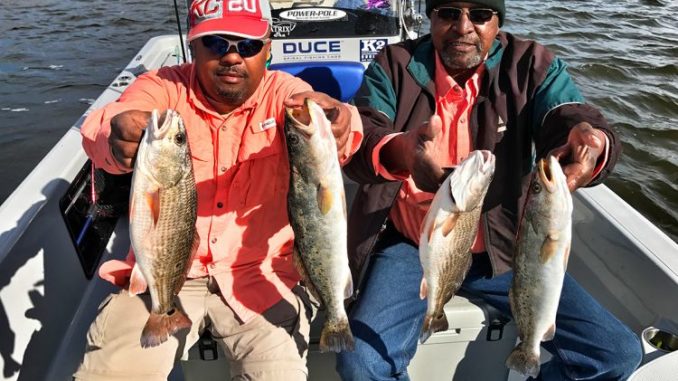
Water temps dictate speckled trout bite
Cold fronts pushing through the state every few days shouldn’t be a reason to stay home — plenty of fishing action can still be found in Dularge, according Capt. Marty LaCoste.
“We caught 80 to 100 redfish (Tuesday), and we ended up with 23 trout,” the owner of Absolute Fishing Charters said.
But that kind of action isn’t an every day occurrence right now. It all depends on two variables: surface water temperatures and tide.
“We had that big cold spell come through (late last week), and the water temperatures fell into the 40s,” LaCoste said. “The trout quit biting.”
But that didn’t hurt the redfish action.
“The redfish stacked up,” he said.
In fact, the day after snow blanketed much of South Louisiana, the guide had a crew on the water absolutely mauling the reds.
When water temps plummet, that’s when it’s time to head to deep holes throughout the Dularge area. Such holes form in the bends of natural bayous, with the best targets being those near shallow flats.
While you can expect to catch numbers of redfish, LaCoste said you likely will have to weed through undersized fish.
“Out of the 100 redfish we caught Tuesday, 40 were keepers,” he said.
If water measures 50 degrees or less, the odds are the trout won’t be interested in feeding.
But if the day warms and bumps water temperatures up just a tad, it’s Katy bar the door.
“Fifty-one to 53 degrees is usually the magic number you look for,” LaCoste said.
As long as there is tidal movement, trout will make up for lost time and gobble up everything within reach.
But without tide, fishing can be a slog. That’s exactly what LaCoste discovered Wednesday.
“After Tuesday’s fishing, I’m thinking, ‘We’re going to kill the reds and trout,'” he said. “But the tide was an early falling tide, so the bite went non-existent.”
He simply waited it out, and then his charters were able to slaughter the trout.
“The tide started coming in and the water temperature hit 51, and the trout went berzerk,” LaCoste said. “We caught them on every cast. We left them biting.”
The best bet is to begin the day working deep holes, and then allow the bite and the weather to dictate where you fish.
“You might limit out in one spot,” LaCoste said. “Or early in the morning, you might catch them in the deep water; then as the day warms up, they’re gong to move out onto the flats.
“If they quit biting (in the deep holes), you want to move and check the shallower water over oyster reefs.”
And the best thing is that live or dead bait is unnecessary.
“We’re catching everything on artificials,” LaCoste said.
Matrix Shad plastics are this guide’s go-to. Effective colors of late have been green hornet and shrimp creole.
He rigs these plastics on 1/4-ounce jigs, tight-lining the lures close to but not on the bottom.
“It’s just a slow, slow, steady retrieve — no twitching,” LaCoste explained. “What I tell people is you want to reel fast enough to keep it just above the bottom. So if you notice you’re coming back with grass or your feeling the bottom and getting hung up, reel just a little faster.”
But don’t expect the rod to be jerked out of your hand.
“(A bite) almost feels like your bait is hung up in the grass,” LaCoste said. “All you feel is a little pressure.”